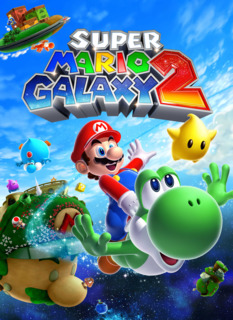The game begins with Peach inviting Mario over for cake. Mario arrives at Peach's castle just as giant Bowser kidnaps Princess Peach and then leaps into space. Mario follows suit but must collect stars in order to power the spaceship that has been gifted to him. The story is threadbare and is just a mash of the stories found in Super Mario 64 and Super Mario Galaxy.
Each world consists of several galaxies which contain one or more chapters, with each chapter containing a star. In these levels, you will either have a large landmass, or many short flat or spherical sections. The mini planets/asteroid are a major idea in the series but are very disorienting since you end up running around them upside-down.
To travel between these small planetary areas, you must find a launch star. Some of them are in plain sight, others appear when the enemies are destroyed in the area, or some other task. A quick shake of the remote uses the launch star and you are sent flying to the next area.
To attack the enemies, you can shake the remote to perform a spin attack, jump on their heads, or launch a star bit at them (aim with the remote and press B). There are a variety of enemies in the game, each with their own behaviours and strategy for defeating them. Mario has his usual jump, triple jump, back-flip to traverse the lands and a butt-stomp to destroy destructible objects.
Each galaxy has a different theme and there is plenty of variety since you are constantly introduced to new types of enemies, platforms and items. These ideas are the reason why the game really excels.
The Fire Flower returns although the Ice Flower doesn't feature. Bee and Boo suits introduced in the previous Galaxy game return. Bee Mario can fly for a limited time and can stick to honeycomb, but will lose the suit when he touches water. Boo Mario can float and pass through certain solid walls. Cloud suit allows Mario to place 3 clouds which act as temporary platforms. The Rock suit allows Mario to transform into a boulder so he can roll over enemies and smash through certain objects. The Drill power up allows Mario to tunnel through dirt to reach the other side of land.
Yoshi features on many of the levels. He has his usual flutter-jump which allows Mario to reach new heights, or can use his tongue to launch off floating flowers. Yoshi can eat most enemies, some which he can spit out to use as a projectile weapon. There's a few power-ups for Yoshi too. The Dash Pepper causes him to run at high speeds for a limited time, Bulb Berry turns Yoshi in to a light-source to illuminate previously invisible floors, and the Balloon Berry makes Yoshi float in the air for a limited time.
This time, you don't have to finish the game to play as Luigi (who has a wider stopping distance, but a higher jump, than Mario). He appears midway through the game and is available to play on certain levels.
The difficulty is mainly very easy, but some levels can be challenging, mainly the extra levels. After collecting the star bits around the levels, either by walking into them or pointing your remote at them, you can then feed them to the 'hungry Lumas' to unlock bonus galaxies.
For a long time now, I have thought it's about time Nintendo removed the 1-Up system from these games. In a level, there will be check-points that you are sent back to when you die, and if you run out of lives, then you are sent back to the start of the level. This only punishes less skilled players but it's not even a harsh punishment compared to the early games that would force you to repeat several levels (this idea was really to inflate the game's short length). On this game, skilful players can't even amass a large amount of lives since they are reset in every play-session. I amassed a whopping 20 lives during the first set of levels, but then had only 5 when I next turned the game on.
There are six Worlds for you to explore in Super Mario Galaxy 2 (with an additional Special World which unlocks after the final showdown). To reach the last boss you only need 70 stars out of the possible 120, so this gives you some flexibility to skip some galaxies, although it's mainly the secret stars you'd be skipping.
There's quite a lot of bosses over the course of the game, with the main bosses being Bowser Jnr. and Bowser. The Bowser battles are the least interesting because every time you face him, you use the same strategy but are up against a slightly more difficult battle. This means that the final boss is disappointing.
Once you complete the game, you can continue to get the remaining stars so there is plenty to do. Graphically, it looks a bit sharper and more colourful than the first game. Galaxy 2 is essentially everything the first game was but with a few new ideas. Overall, Mario Galaxy is a good game and is an interesting change in the Mario series, but is let down by being too easy overall and for being quite disorienting in a few places.

